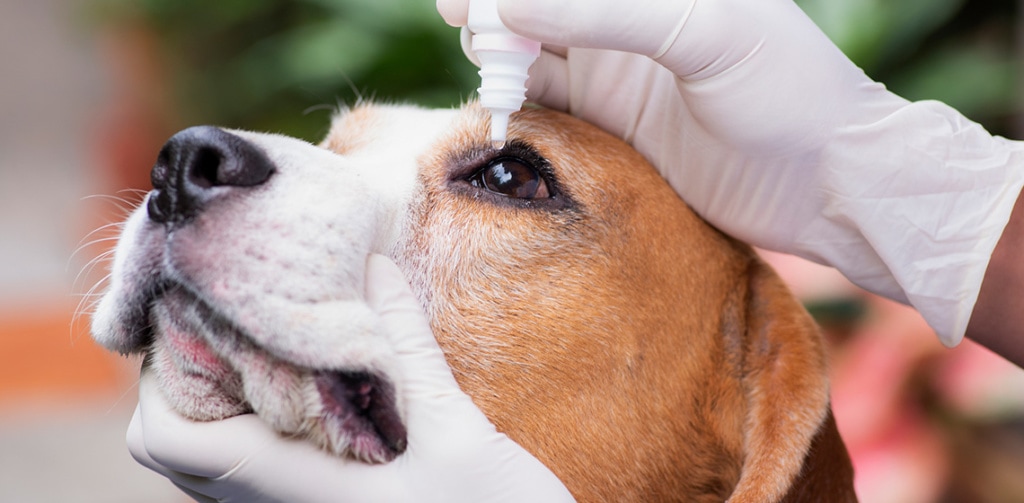Traumatic eye injuries in dogs are common and usually result from sticking their nose into something they shouldn’t or playing rough with other dogs or cats. Your dog can be affected by different types of eye injury, however, they all require veterinary attention.
Severity:
Mild to moderate to severe
Table of Contents
Key points
- Always seek veterinary attention
- Even mild injuries may lead to infection, scarring, or vision loss
- Symptoms include rubbing at the eye, squinting, watery or yellow-green discharge, redness, and swelling
- Treatment will depend on the type of injury and which parts of the eye are affected
Common in:
Dogs of any age or sex but may be more common in young dogs and puppies, as well as working breeds like Labradors and English Springer Spaniels.
Symptoms and types:
Signs associated with eye injuries in dogs may affect one or both eyes and include:
- Pawing at or rubbing at the affected eye or the face
- Squinting (‘blepharospasm’) or struggling to open the eye
- Blinking excessively
- Increased tear production (watery eye)
- Green or yellow discharge
- Reddening of the whites of the eye (the ‘sclera’)
- Swollen or red eyelids or conjunctiva
- Evidence of injuries such as wounds or blood. In severe cases of trauma, the eye may even pop out of its socket (‘proptosis’)
If your dog is showing any of these symptoms, it’s important to seek urgent veterinary attention. Prompt diagnosis and treatment are essential to give the eye the best chance of healing.
As the eye is so sensitive it’s best to contact your vet before attempting any first aid at home.
Understanding the diagnostics
- Your vet will start by taking a thorough case history before examining the eye closely. They will often apply local anesthetic eye drops to make the sensitive and often painful eye area more comfortable.
- An ophthalmic (eye) exam will be performed with the use of a focal light source or slit lamp to check for trauma and to assess pupil size and reflexes. This will help a vet for dogs to determine the extent of the damage and which parts of the eye have been affected.
- Fluorescein stain is a simple diagnostic test used to check for a corneal ulcer (scratch or wound to the outer surface of the eye). An orange stain is applied that shows up any defects under blue light.
- Your vet may also check the intraocular pressure (how hard or soft the eye is) using a Tonopen or Tonovet device. Changes in intraocular pressure can be used to diagnose diseases such as uveitis (an inflammatory condition) and glaucoma.
Learning about the causes
So, what are the most common types of eye injuries in dogs?
1. Corneal ulcers and lacerations
A corneal ulcer is a defect that can also include cuts (laceration) to the outermost surface of the eye (the cornea). Corneal ulcers can be caused by any type of trauma such as a curious pup sticking their head into a bush, a swipe from an angry cat, or even a chemical injury from the shampoo used at bath time. Because corneal ulcers are painful and can develop serious infections, they require urgent veterinary attention.
2. Foreign bodies and penetrating injuries
Objects like grass seeds, splinters, dust, and debris are examples of ‘foreign bodies’ or material that can cause inflammation, trauma, and infection if not removed quickly. Foreign bodies are often found under the eyelids but can also cause deeper injury to the eye itself (a penetrating injury).
3. Eyelid laceration
Lacerations (cuts) and wounds affecting the eyelids are also common especially after contact with sharp objects or after a fight with another dog (or cat!). The eyelid plays an important role in protecting the eye and any changes to its shape can result in irritation to the surface of the eye over time. Eyelid lacerations usually require surgical repair.
4. Blunt trauma and proptosis
Blunt trauma, dog bite wounds, or other forces applied to the head can cause bleeding into the eye (hyphema) and other serious damage including the eye-popping out of the socket (proptosis). This is an emergency requiring immediate veterinary attention.
Best treatment options
Prompt diagnosis and treatment are essential to give the eye the best chance of healing.
Treatment options will vary depending on the type and severity of the eye injury. A mild corneal ulcer is often effectively treated with antibiotic eye drops and pain relief but more complicated cases, such as deep and infected ulcers or penetrating injuries, may require referral to a veterinary ophthalmologist (eye specialist) for advanced treatment options. Despite the best veterinary care, an eye injury may still result in permanent scarring or blindness.
Dogs with proptosis may be able to have their eye put back into place surgically, but unfortunately, if the eye has been too severely damaged it may need to be removed (‘enucleation’). Most eyelid injuries also require surgery to repair the damage, but these tend to heal well unless a large part of the eyelid has been damaged.
Home remedies and their effectiveness
Never attempt to treat an eye injury yourself at home. Something as simple as applying the wrong eye drop or using an irritating cleaning solution could have serious consequences and make matters worse.
As the eye is so sensitive it’s best to contact your vet before attempting any first aid at home. However, here are a few key tips for emergencies:
- Do not attempt to push the eye back into place if it has popped out of the socket but do apply sterile KY jelly or a moist compress until you get to the vet
- Do gently rinse the eye with saline or running water if your dog has gotten a chemical in their eye
- Do not try to remove foreign material from the eye
When to see a vet
You can never be too careful with an eye injury and it’s best to see a vet as soon as possible so they can assess the extent of the damage and recommend a suitable treatment plan.
FAQ
All eye injuries should be treated seriously because even mild injuries can lead to scarring or vision loss. Bleeding wounds after a dog fight or proptosis (eye popped out of the socket) are extremely serious and should be treated as an emergency.
In some cases, yes. Certain injuries like corneal ulcers or scratches may heal on their own, but they still need to be assessed by a vet. If an infection develops, or there is foreign material like a grass seed still lodged within the eye, the consequences can be severe.
Depending on the type of injury this could be a few days to weeks. A simple corneal ulcer should heal within 7 days and an eyelid injury that has been surgically repaired should heal within 7-10 days. However, deep ulcers or penetrating eye injuries may take weeks of intensive treatment or longer to heal completely.
Your vet will often recommend that your dog wears an Elizabethan collar (cone) after an eye injury for protection. Keeping them indoors where possible (leash walk to the toilet) and away from sharp objects and other pets is also useful.
Treatment will depend on the type of injury and will range from eye drops and pain relief for a mild corneal ulcer to surgery for a more serious injury. Make sure to follow your vet’s instructions carefully when administering treatment.

Ellen is an Australian vet who is currently combining her love of writing with traveling and working across the UK as a relief vet. Ellen graduated from the University of Melbourne in 2012 and is passionate about all things small animal health. Since graduating she has worked in clinical practice, including at a university teaching hospital in New Zealand. Ellen is currently based in Somerset and in her free time enjoys yoga, reading, travel, and modern calligraphy!








